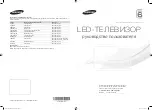
1 Safety precautions
General guidelines
1. When servicing, observe the original lead dress. If a
short circuit is found, replace all parts which have been
overheated or damaged by the short circuit.
2. After servicing, see to it that all the protective devices
such as insulation barriers, insulation papers shields are
properly installed.
3. After servicing, make the following leakage current
checks to prevent the customer from being exposed to
shock hazards.
Leakage current cold check
1. Unplug the AC cord and connect a jumper between the
two prongs on the plug.
2. Measure the resistance value, with an ohmmeter,
between the jumpered AC plug and each exposed
metallic cabinet part on the equipment such as
screwheads, connectors, control shafts, etc. When the
exposed metallic part has a return path to the chassis,
the reading should be between 1M and 5.2M. When the
exposed metal does not have a return path to the
chassis, the reading must be infinite.
Figure 1. Hot check circuit
Leakage current hot check
1. Plug the AC cord directly into the AC outlet. Do not use
an isolation transformer for this check.
2. Connect a 1.5k, 10 watts resistor, in parallel with a
0.15F capacitors, between each exposed metallic part
on the set and a good earth ground such as a water
pipe, as shown in Figure 1.
3. Use an AC voltmeter, with 1000 ohms/volt or more
sensitivity, to measure the potential across the resistor.
4. Check each exposed metallic part, and measure the
voltage at each point.
5. Reverse the AC plug in the AC outlet and repeat each of
the above measurements.
6. The potential at any point should not exceed 0.75 volts
RMS. A leakage current tester (Simpson Model 229
orequivalent) may be used to make the hot checks,
leakage current must not exceed 1/2 milliamp. In case a
measurement is outside of the limits specified, there is
a possibility of a shock hazard, and the equipment
should be repaired and rechecked before it is returned
to the customer.
2 Warning
2.1. Prevention of Electro Static
Discharge (ESD) to
Electrostatically Sensitive (ES)
Devices
Some semiconductor (solid state) devices can be damaged
easily by static electricity. Such components commonly are
called Electrostatically Sensitive (ES) Devices. Examples of
typical ES devices are integrated circuits and some field-
effect transistors and semiconductor "chip" components.
The following techniques should be used to help reduce the
incidence of component damage caused by electro static
discharge (ESD).
1. Immediately
before
handling
any
semiconductor
component or semiconductor-equipped assembly, drain off
any ESD on your body by touching a known earth ground.
Alternatively, obtain and wear a commercially available
discharging ESD wrist strap, which should be removed for
potential shock reasons prior to applying power to the unit
under test.
2. After removing an electrical assembly equipped with ES
devices, place the assembly on a conductive surface such
as alminum foil, to prevent electrostatic charge buildup or
exposure of the assembly.
3. Use only a grounded-tip soldering iron to solder or unsolder
ES devices.
4. Use only an anti-static solder removal device. Some solder
removal devices not classified as "anti-static (ESD
protected)" can generate electrical charge sufficient to
damage ES devices.
5. Do not use freon-propelled chemicals. These can generate
electrical charges sufficient to damage ES devices.
6. Do not remove a replacement ES device from its protective
package until immediately before you are ready to install it.
(Most replacement ES devices are packaged with leads
electrically shorted together by conductive foam, alminum
foil or comparable conductive material).
7. Immediately before removing the protective material from
the leads of a replacement ES device, touch the protective
material to the chassis or circuit assembly into which the
device will be installed.
Caution
Be sure no power is applied to the chassis or circuit, and
observe all other safety precautions.
8. Minimize bodily motions when handling unpackaged
replacement ES devices. (Otherwise hamless motion such
as the brushing together of your clothes fabric or the lifting
of your foot from a carpeted floor can generate static
electricity (ESD) sufficient to damage an ES device).
3
Summary of Contents for TC-26LX600 - 26" LCD TV
Page 7: ...6 Location of controls EUR7613ZF0 7 ...
Page 14: ...11 Boards Assemblies 11 1 AP Board 14 ...
Page 15: ...11 2 A Board 15 ...
Page 16: ...11 3 P Board 16 ...
Page 17: ...11 4 G Board 17 ...
Page 18: ...11 5 DT Board 18 ...
Page 19: ...11 6 DT Board with shield 19 ...
Page 20: ...11 7 V Board 20 ...
Page 31: ...13 Schematic Diagrams 13 1 Schematic Diagrams Notes 31 ...
Page 32: ...13 2 Reference of PDF links color 32 ...
Page 38: ...13 8 G Board Schematic Diagram 38 ...
Page 39: ...1 2 3 4 5 6 7 8 A B C D E F G H I J G BOARD TNPA3784 TC 26LX600 TC 32LX600 39 ...
Page 42: ...14 3 AP Board 0 1 2 J I F 7777777 EJ L 777777 I IK77777 A BBC7 A BB 42 ...
Page 43: ...14 4 DT Board Bottom Side 0 1 2 34 5 6 7777777389 4 777777 5335 777773 4 73 4 43 ...
Page 44: ...14 5 DT Board Top Side 0 1 2 34 5 6 7777777389 4 777777359777773 4 73 4 44 ...
Page 46: ...15 Parts Location LCD TV Exploded View 15 1 Packing Exploded View Package contents 46 ...
Page 47: ...16 Parts list 16 1 Description of abbreviations guide 47 ...
Page 65: ...1 5 AP BOARD FOIL SIDE A B C D E F G H I 1 2 3 4 5 6 AP BOARD FOIL SIDE 7 ...
Page 66: ...1 6 AP BOARD COMPONENT SIDE A B C D E F G H I 1 2 3 4 5 6 AP BOARD COMPONENT SIDE 8 ...




































